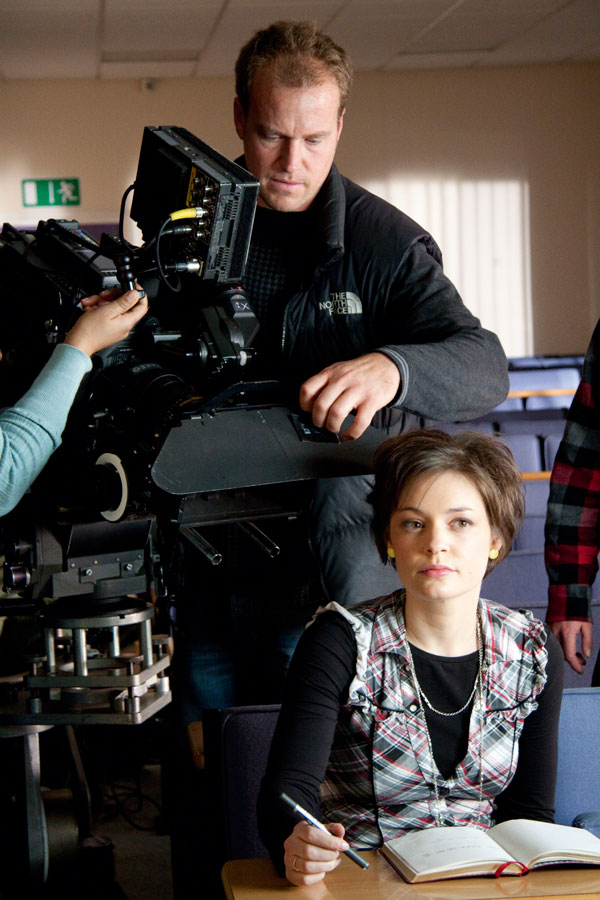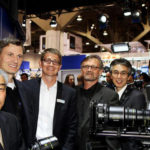
The Calculus Of Love
Posted on Apr 19, 2010 by Alex Fice
DP Dirk Nel with Sony SRW9000 and ‘Hopkins’ © Pippa HealyWhen I first got the call from Dan Clifton to work with him on The Calculus Of Love I was very excited to collaborate on a fictional piece after working with him on a number of documentaries. Dan is great to work with he is very flexible in his approach and fast on his feet which comes from the documentary background. I like the organic feel to his style, once again born out of documentary. For example if an actor leans out of frame or there is a focus buzz on a take it’s all part of that organic feel which I feel we have lost to a large degree in cinema
The film involves a Mathematics Professor Bowers who for the better half of his life has grappled with the 250 year old unsolved Goldbach Conjecture which states that any number greater than 2 is the sum of two primes. Reknown for being one of the world’s leading mathematicians he runs a tight ship and his class is seen as hallowed ground.
The beginning of a new term sees a young student called Hopkins join his class who clearly has an aptitude for the subject. Bowers has more in common with Hopkins than he realises.
Working with the SRW-9000
I first heard about this camera through a colleague who had been to a Sony presentation of it. He was amazed at the spec and price of it which intrigued me so I called up Mike Thomas at Top Teks and asked if he would mind me having a play. I mentioned the short film Dan and I were planning and he offered to let us use it on the production which was fantastic.
At first sighting I thought it bulky and pretty un-ergonomic but realised that unlike the F35 it’s recording system the SR deck was built into the chassis.
The 2/3in chip presented a problem for our purposes because I wanted a shallow DOF to hide some of the aberrations on set. So we decided to use a Pro 35 adapter with it. Take 2 Films very kindly offered up the lenses and grip equipment. I wanted to use the Master Primes because of their speed to compensate for the Pro 35 1.5 stop loss but after a little hiccup with insurance they became unavailable and we ended up using the Zeiss Ultra Primes T1.9s which are beautiful lenses. I decided not to use any filtration once again because of the Pro 35 and loss of resolution shooting through the extra glass but as it turned out I feel that helped aesthetically it seemed to tame the sharpness that’s so apparent with HD at this level. I wanted to shoot using the full gamut the camera has to offer which with the correct boards is 4:4:4 in Sony’s S log which is essentially raw and allows for the greatest elasticity in post. For more than half of the film I had 3db of gain in the camera which according to Sony rates the camera at 500ASA – this helped me a lot having lost 1.5 stops using the Pro35, it also increases the dynamic range of the camera at the cost of a little noise which I felt suited those particular scenes.
Hilda Sealy my first AC had a difficult task with pretty much everything being shot wide open on the Ultra Primes. We have worked together for awhile now and she deals with this with gusto. We used the dolly a fair bit and ended up shooting a lot of our scenes in one or two setups which under the time constraints was a necessity but a conscious decision in our prior planning.
Dan and I spoke about many films and referenced a wide spectrum of looks including Hard Candy for the feeling of claustrophobia that the director creates.
In the Italian film Consequences Of Love we spoke about the look being very unforced and natural light which is always a lot easier to create than one imagines especially with a limited lighting package. The colour palate was fairly uniform, nothing jumping out. Framing was important to single out our main character Prof Bowers (Keith Allen) we wanted to isolate him and so we opted for wide frames with big head room and placing him in bottom left or right of frame when we could.
My lighting approach was simple, the package included 1X 4K HMI and 3X 2.5K HMI, two Image 80s, two Diva lights, and a small tungsten package. I wanted to create a natural feel not stylised so as not to detract from the characters but have them immersed in a natural environment which we tried to make feel claustrophobic. we used blinds on the windows so you can barely see outside which enhances the claustrophobia, this presents challenges in being able to light from the outside.. bowers world is an internal one and the blinds feature both in his office space and the lecture room which is the space he occupies physically and mentally.
The final scene I feel is interesting photographically it takes place in what is supposed to be the basement of the university. I didn’t have a gaffer on this day so we were restricted in what we could achieve. The scene is lit with three Cooly lamps which feature in the shot, each lamp had a 100W undiffused pearl bulb in it and this is all we had apart from two small tungsten fresnels on the back walls. The scene was shot wide open with 3db gain and the camera handled it marvellously the stop range was from 5.6 in the highlights under the lamp to 1.1 in the shadows. Keith Allen is balding and I thought a shiny head would be a problem in this scenario but the camera handled well.








